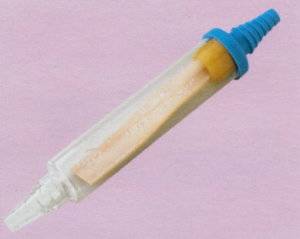Flutter valve
Flutter Valve
The flutter valve, also known as the Heimlich valve, is a one-way valve used in medical settings to allow air or fluid to escape from a body cavity while preventing it from re-entering. It is commonly used in the management of pneumothorax and other conditions where air or fluid needs to be evacuated from the pleural cavity.
Design and Function[edit | edit source]
The flutter valve is typically constructed from a flexible material, such as rubber or silicone, and consists of a flat or cylindrical tube with a slit or flap that opens to allow air or fluid to pass through in one direction. The valve closes when pressure attempts to reverse the flow, thus preventing backflow.
The valve is often attached to a chest tube, which is inserted into the pleural space. As the patient breathes, air or fluid is expelled through the valve, reducing pressure in the pleural cavity and allowing the lung to re-expand.
Clinical Applications[edit | edit source]
The flutter valve is primarily used in the treatment of pneumothorax, a condition where air accumulates in the pleural space, causing the lung to collapse. It is also used in cases of pleural effusion, where fluid accumulates in the pleural cavity.
In emergency situations, the flutter valve can be a lifesaving device, allowing for rapid decompression of the pleural space. It is often used in pre-hospital settings, such as by paramedics, and in military medicine.
Advantages[edit | edit source]
The flutter valve offers several advantages:
- Portability: It is lightweight and compact, making it easy to transport and use in various settings.
- Simplicity: The design is straightforward, requiring minimal training to use effectively.
- Safety: By preventing backflow, the valve reduces the risk of infection and further complications.
Limitations[edit | edit source]
While the flutter valve is effective in many situations, it has limitations:
- Limited to specific conditions: It is not suitable for all types of chest injuries or conditions.
- Potential for blockage: The valve can become blocked by thick fluids or debris, necessitating careful monitoring.
Related Pages[edit | edit source]
Transform your life with W8MD's budget GLP1 injections from $125 and up biweekly
W8MD offers a medical weight loss program NYC and a clinic to lose weight in Philadelphia. Our W8MD's physician supervised medical weight loss centers in NYC provides expert medical guidance, and offers telemedicine options for convenience.
Why choose W8MD?
- Comprehensive care with FDA-approved weight loss medications including:
- loss injections in NYC both generic and brand names:
- weight loss medications including Phentermine, Qsymia, Contrave, Diethylpropion etc.
- Accept most insurances for visits or discounted self pay cost.
- Generic weight loss injections starting from just $125.00 for the starting dose
- In person weight loss NYC and telemedicine medical weight loss options in New York city available
Book Your Appointment
Start your NYC weight loss journey today at our NYC medical weight loss, and Philadelphia and visit Philadelphia medical weight loss Call (718)946-5500 for NY and 215 676 2334 for PA
Search WikiMD
Ad.Tired of being Overweight? Try W8MD's NYC physician weight loss.
Semaglutide (Ozempic / Wegovy and Tirzepatide (Mounjaro / Zepbound) available. Call 718 946 5500.
Advertise on WikiMD
|
WikiMD's Wellness Encyclopedia |
| Let Food Be Thy Medicine Medicine Thy Food - Hippocrates |
Translate this page: - East Asian
中文,
日本,
한국어,
South Asian
हिन्दी,
தமிழ்,
తెలుగు,
Urdu,
ಕನ್ನಡ,
Southeast Asian
Indonesian,
Vietnamese,
Thai,
မြန်မာဘာသာ,
বাংলা
European
español,
Deutsch,
français,
Greek,
português do Brasil,
polski,
română,
русский,
Nederlands,
norsk,
svenska,
suomi,
Italian
Middle Eastern & African
عربى,
Turkish,
Persian,
Hebrew,
Afrikaans,
isiZulu,
Kiswahili,
Other
Bulgarian,
Hungarian,
Czech,
Swedish,
മലയാളം,
मराठी,
ਪੰਜਾਬੀ,
ગુજરાતી,
Portuguese,
Ukrainian
Medical Disclaimer: WikiMD is not a substitute for professional medical advice. The information on WikiMD is provided as an information resource only, may be incorrect, outdated or misleading, and is not to be used or relied on for any diagnostic or treatment purposes. Please consult your health care provider before making any healthcare decisions or for guidance about a specific medical condition. WikiMD expressly disclaims responsibility, and shall have no liability, for any damages, loss, injury, or liability whatsoever suffered as a result of your reliance on the information contained in this site. By visiting this site you agree to the foregoing terms and conditions, which may from time to time be changed or supplemented by WikiMD. If you do not agree to the foregoing terms and conditions, you should not enter or use this site. See full disclaimer.
Credits:Most images are courtesy of Wikimedia commons, and templates, categories Wikipedia, licensed under CC BY SA or similar.
Contributors: Prab R. Tumpati, MD




